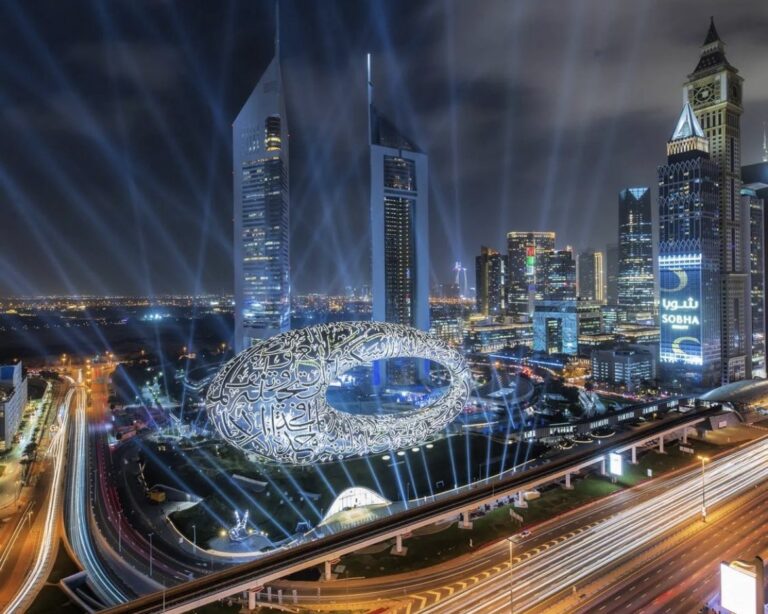In just a few years, Dubai’s cityscape has changed tremendously. From the first timid skyscrapers, the Emirate’s skyline has become populated with futuristic buildings of all shapes and sizes.
The capital of the most exaggerated architecture, Dubai is definitely a must-see destination if you want to visit some of the world’s tallest skyscrapers and buildings with the most incredible shapes.
Table of Contents
Dubai’s skyline: towering skyscrapers and curious shapes
Dubai’s first skyscrapers were built around the main street, Sheikh Zayed Road. However, in a very short time they were surpassed in height by incredible new projects in other urban areas of the city.
For example, the Jumeirah Lakes Towers district, abbreviated as JLT, is home to numerous office skyscrapers. In contrast, Dubai Marina and Jumeirah Beach Residence, called JBR by locals, are home to residential buildings, restaurants and other attractions for tourists and expats.
1. Burj Al Arab: the sail-shaped palace with seven-star hotel
The Burj Al Arab is the iconic sail palace commissioned for the purpose of making Dubai recognizable worldwide. For its unusual form, architect Tom Wright was inspired by the sail of dhows, the typical boats of the United Arab Emirates.
The façade is made of fiberglass for the dual purpose of shielding the desert sun during the day and lending itself as an unusual screen for lighting at night. Built on an artificial island overlooking Jumeirah Beach, Burj Al Arab’s records include the heliport that hosted the historic tennis match between Roger Federer and Andre Agassi, a fleet of Rolls Royce limousines, and the number of stars in its hotel.
In fact, the Burj Al Arab called itself “the only seven-star hotel in the world” because it is the only one with only suites. However, the international classification recognized only the classic five, positioning it as five-star luxury.
2. Burj Khalifa: the world’s tallest skyscraper
With a dizzying height of 828 meters, the Burj Khalifa is currently the tallest building in the world. Its space rocket-like shape perfectly reflects the spirit in which it was built, seemingly a resort to build the longest building.
In fact, the shape of the Burj Khalifa echoes the shape of the hymenocallis flower, as you can see in the videos that capture it from above. To make it even more spectacular, the surface is covered with 28,000 glass panels that light up in the evening in a music and light show that you can watch from the Dubai Mall.
The Burj Khalifa can also be visited, either by booking dinner at the restaurant on the 122nd floor or by going up to the two viewing points. The first on the 124th and 125th floors and the second on the 148th floor. Ticket prices vary depending on the floor you want to visit and the time of day. In fact, sunset is definitely the most scenic time to discover Dubai from above.
3. Dubai Frame: the world’s largest frame
One of the emirate’s most incredible attractions is the Dubai Frame, a giant frame that frames the old city on one side and futuristic skyscrapers built in recent years on the other.
Designed precisely with the intention of creating the world’s largest frame, this building is 150 meters high and the structure consists of two columns with panoramic ascenders joined by a walkway with a transparent floor.
Between selfie stations and green screens with photographer, the visit is punctuated by moments to remember, before arriving at a Dubai Frame-themed gift store, where you can admire an incredible number of gilded frames all at once.
4. Museum of the Future: a glimpse into the coming global development
With an incredible oval shape decorated with Arabic script that lights up as the sun goes down, Dubai’s Museum of the Future is one of the attractions built for Expo 2020 (postponed to 2021 due to the Covid pandemic).
The exhibition space is inspired by immersive exhibits on government services, health care, climate change and food security created in the previous five years for the World Government Summit, a global platform held annually in Dubai.
The four floors of the Museum of the Future focus on the possible futures of resource development, ecosystems and bioengineering, with space dedicated to presenting the technologies of the near future. The top floor, on the other hand, is entirely dedicated to children, with a world to explore and challenges to complete.
5. Etihad Museum: the museum of the birth of the United Arab Emirates
The Etihad Museum is one of the most beautiful history museums in the world. Futuristic architecture and multimedia installations take visitors through the journey of the UAE’s union.
In fact, the museum’s itinerary traces the choice of the emirates of Abu Dhabi, Ajman, Dubai, Fujaira, Ras al-Khaimah, Sharja and Umm al-Qaywayn to become a federation.
The shape of the building echoes the parchment of the unification treaty, while the golden columns in the entrance represent the pens with which it was signed. The large empty spaces are interspersed with blow-ups of the fathers of the homeland and films of the UAE’s achievements for a museum that certainly does not go unnoticed. In fact, its 25,000 square meters are an architectural masterpiece meant to stick with visitors.
Read also: Smart City Dubai, where luxury meets sustainability: the projects on the plate












